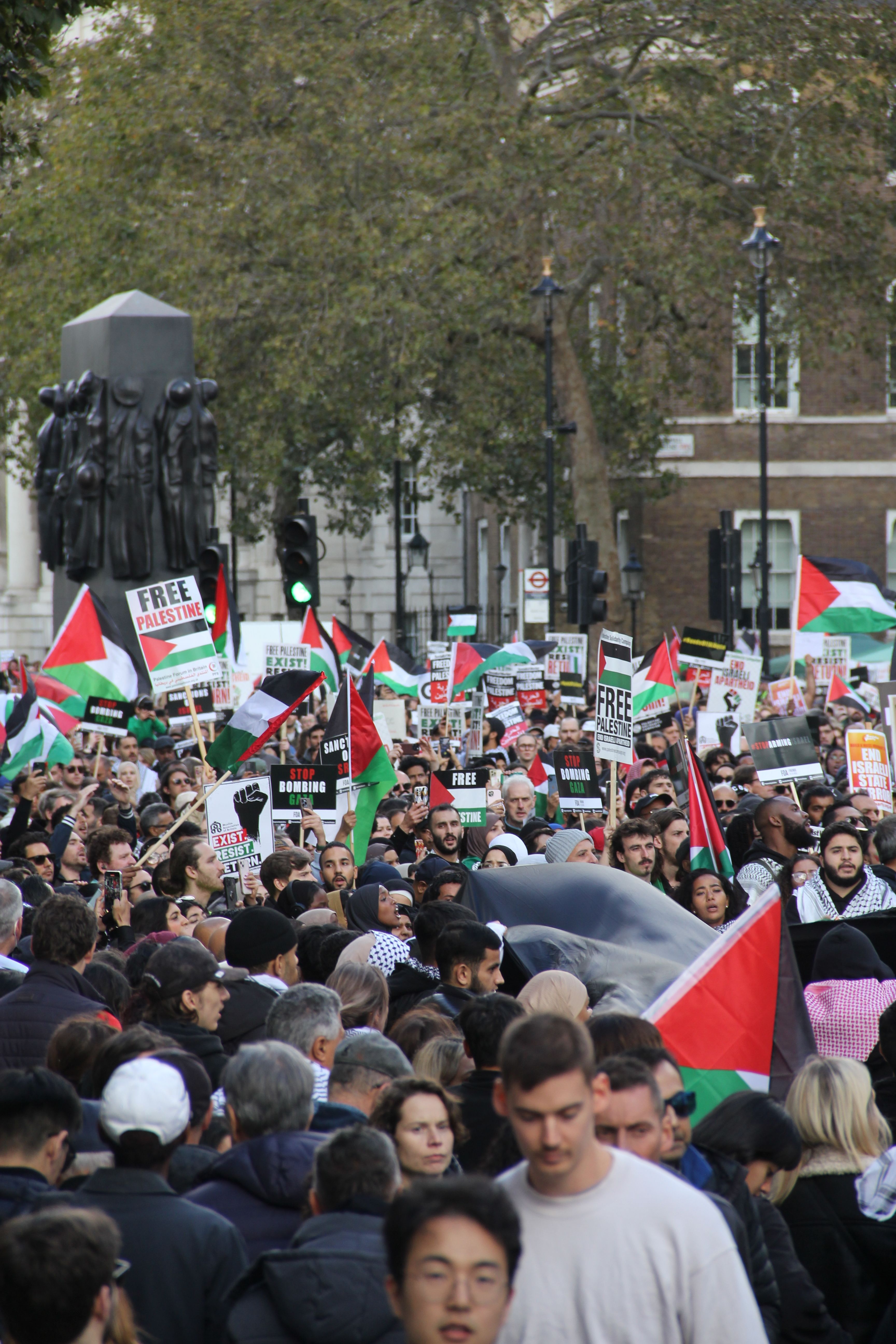The London Palestine Protests in Pictures
Images and article by Archie Clarke
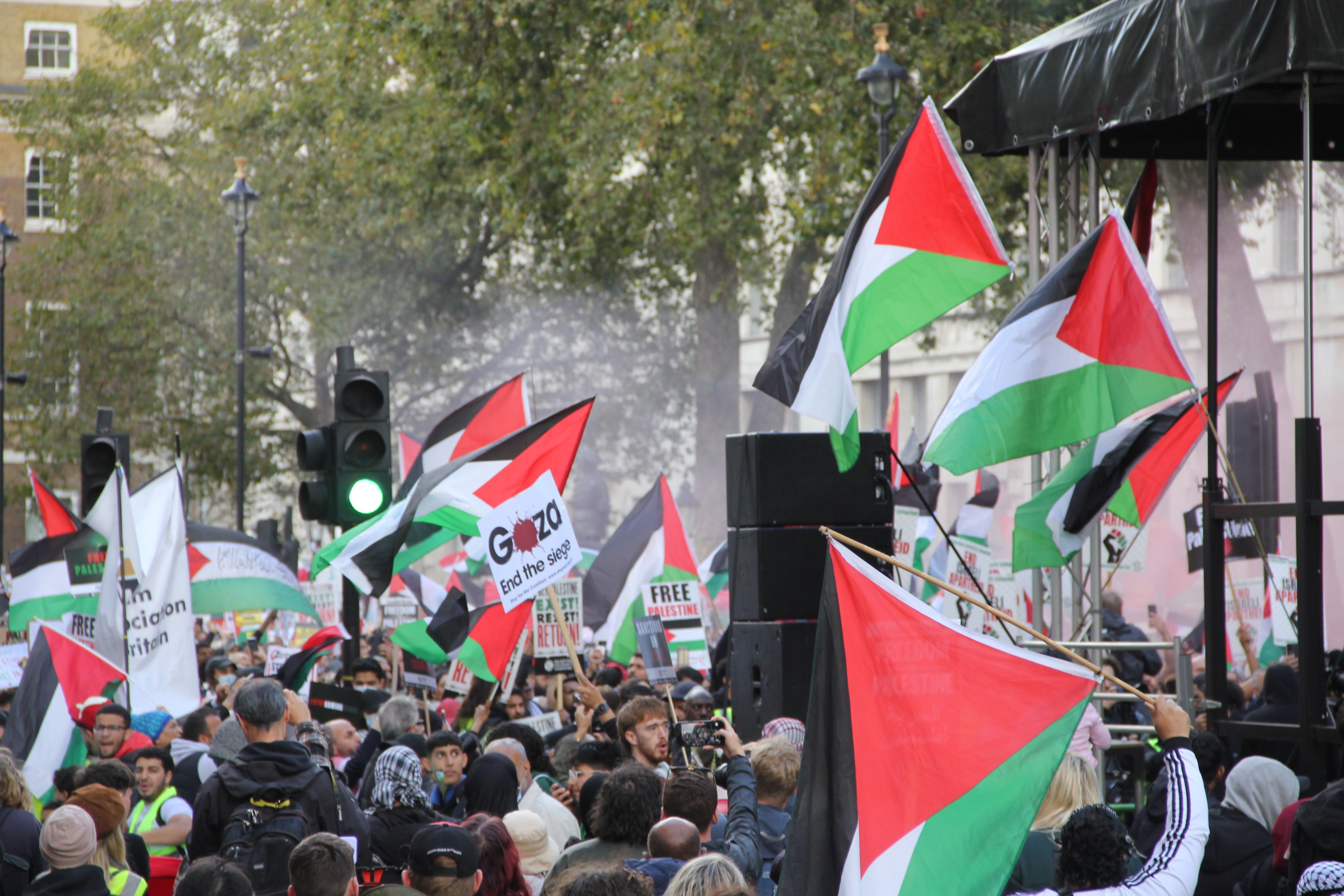
Tens of thousands of people attended a pro-Palestine march in London on October 14. Whilst events of this size have been held in the city before, this protest felt different. The passion of the protestors was evident as all present voiced their anger at Israel’s recent and past actions. The march was a conglomeration of many different groups. They ranged from Socialist Appeal, a Marxist organisation that stands for a socialist transformation of society, to the Muslim Council of Britain which organised coaches for protestors to attend the rally from towns such as Aylesbury. The rally was attended by a wide demographic. Both university and school students were present in large numbers alongside seniors. The spark for the protest came with the recent conflict between Israel and Hamas which at the time had claimed the lives of 2,200 Palestinians and 1,000 Israelis. Alongside a focus on the Palestinian deaths the siege of Gaza was front and centre of the protests. The Israeli government announced a “complete siege”, in which “There will be no electricity, no food, no fuel”, a week before the march. The demonstration was in stark contrast to the British government’s long-standing support of Israel and Prime Minister Rishi Sunak’s pledge to provide “unqualified support in the face of evil”.
Before the Protest
Protestors gathered with event organisers at 10:30 AM outside BBC Broadcasting House, a full hour and a half before the march was scheduled to start. The building has red paint on it from the previous night when it was vandalised by members of Palestine Action. The group claims the BBC has “blood on its hands”, due to its coverage of the conflict in Gaza.
The event was well organised and there was heavy emphasis that it should remain peaceful. Before the main bulk of protestors arrived volunteers were formed into steward teams to keep the protest moving and prevent a backlog. They were also instructed to tell protestors who were seen breaking the law or provoking violence to stop to keep the demonstration peaceful.
The speech ended with organisers thanking protestors and telling students in the crowd to “go back to your colleges and spread the word, bring ten people next time.”
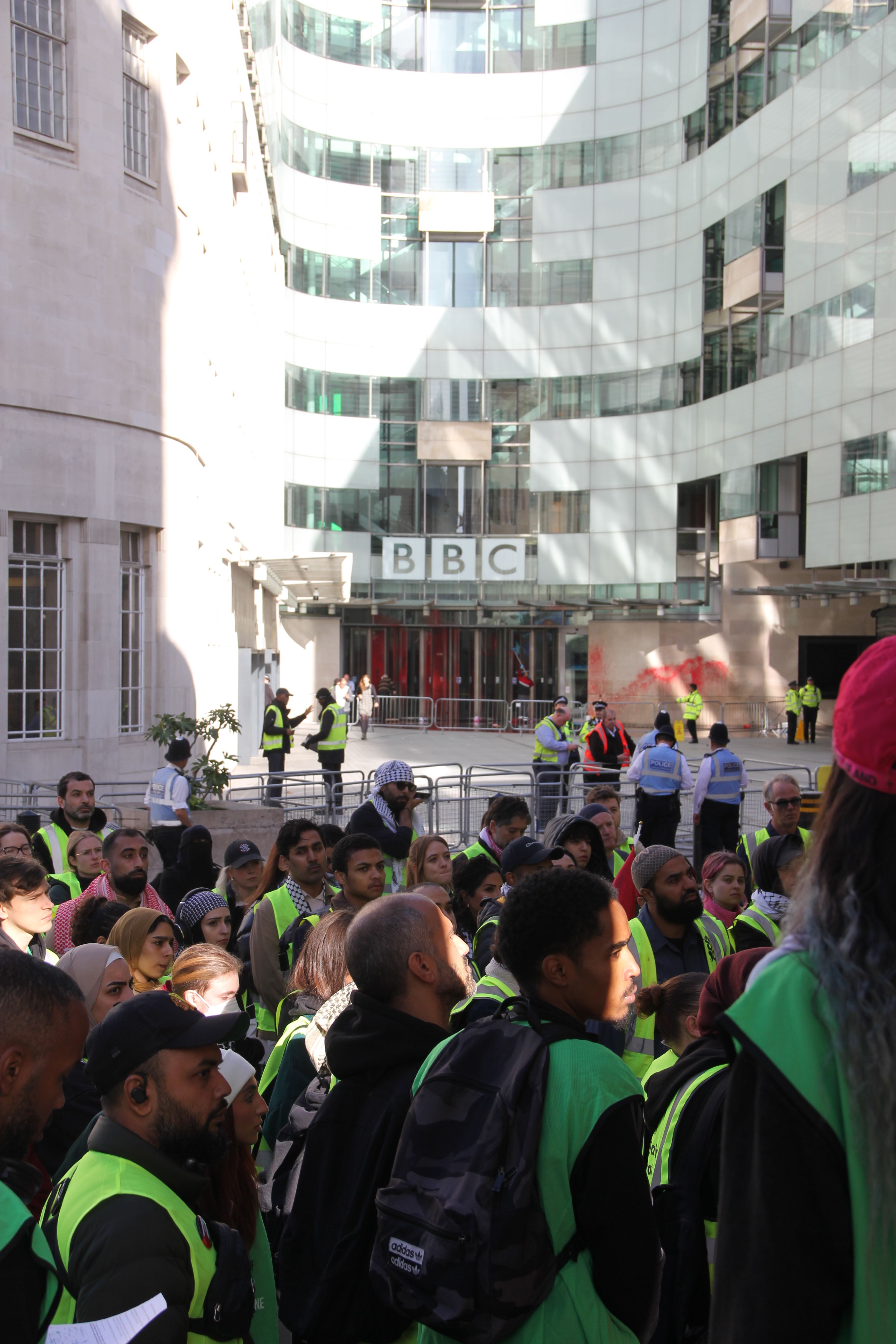
Homemade signs
Whilst not as common as other mass-produced placards, the homemade signs provided a personal touch to their message. All were happy with their photo being taken and proudly displayed their signs all day.
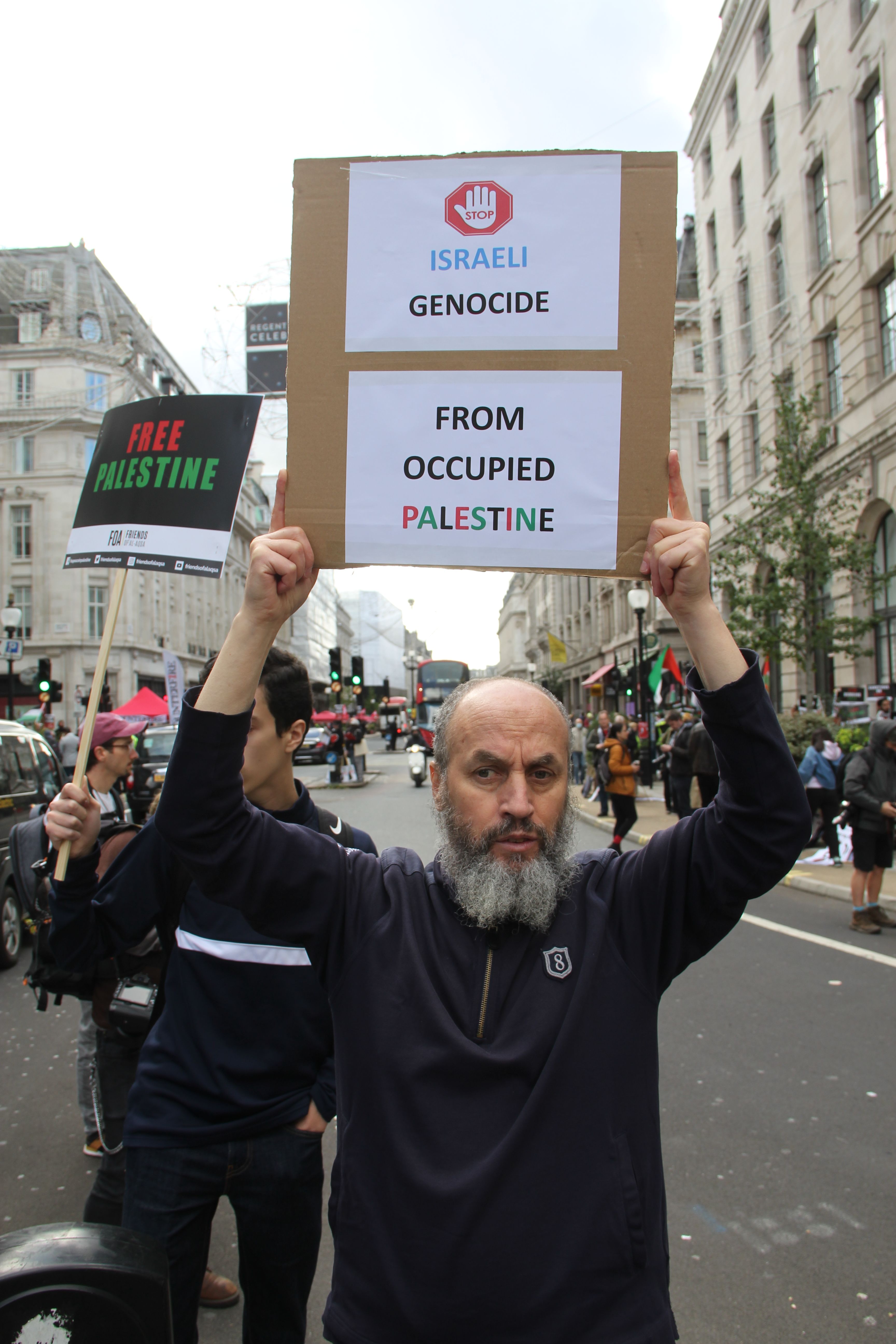
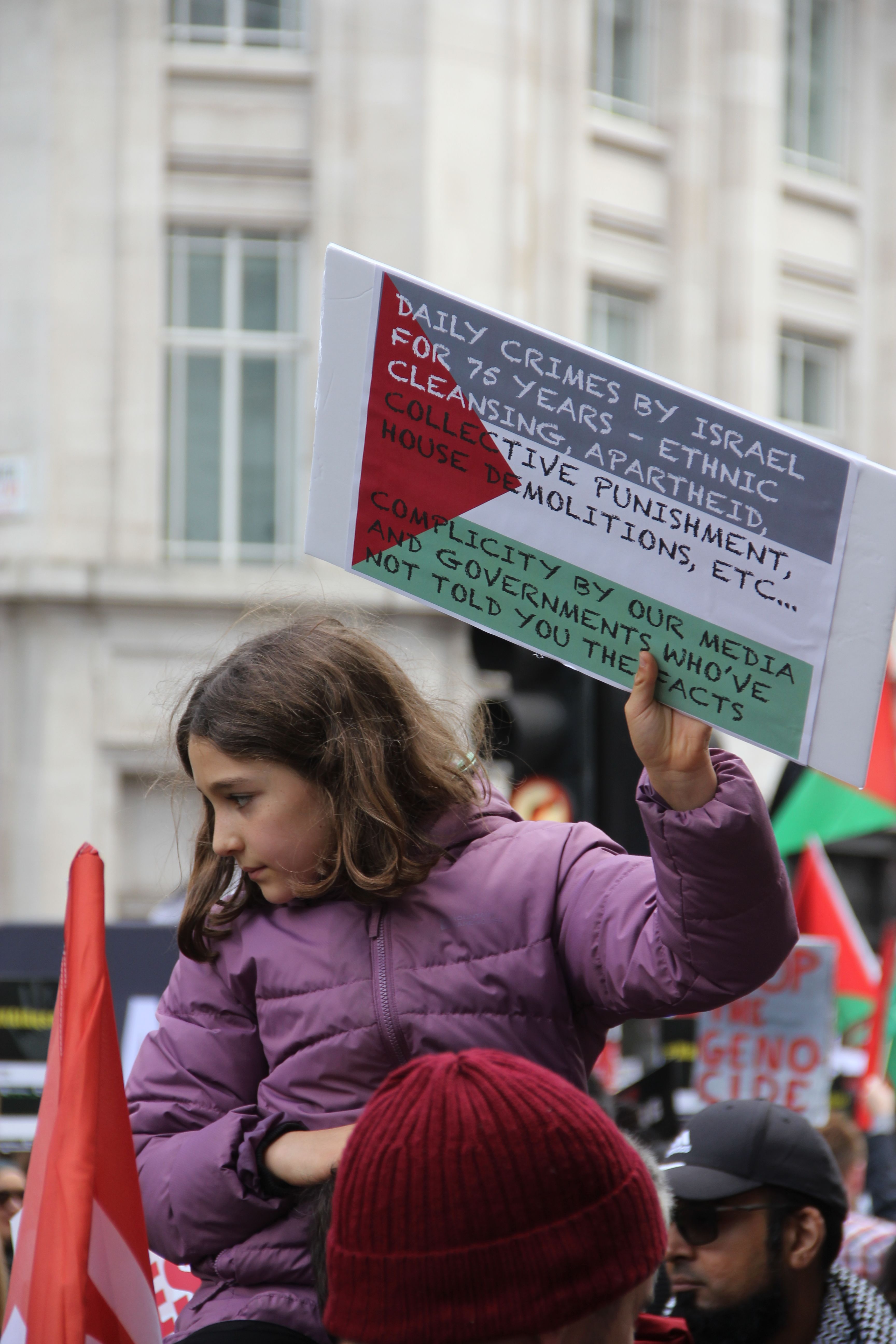
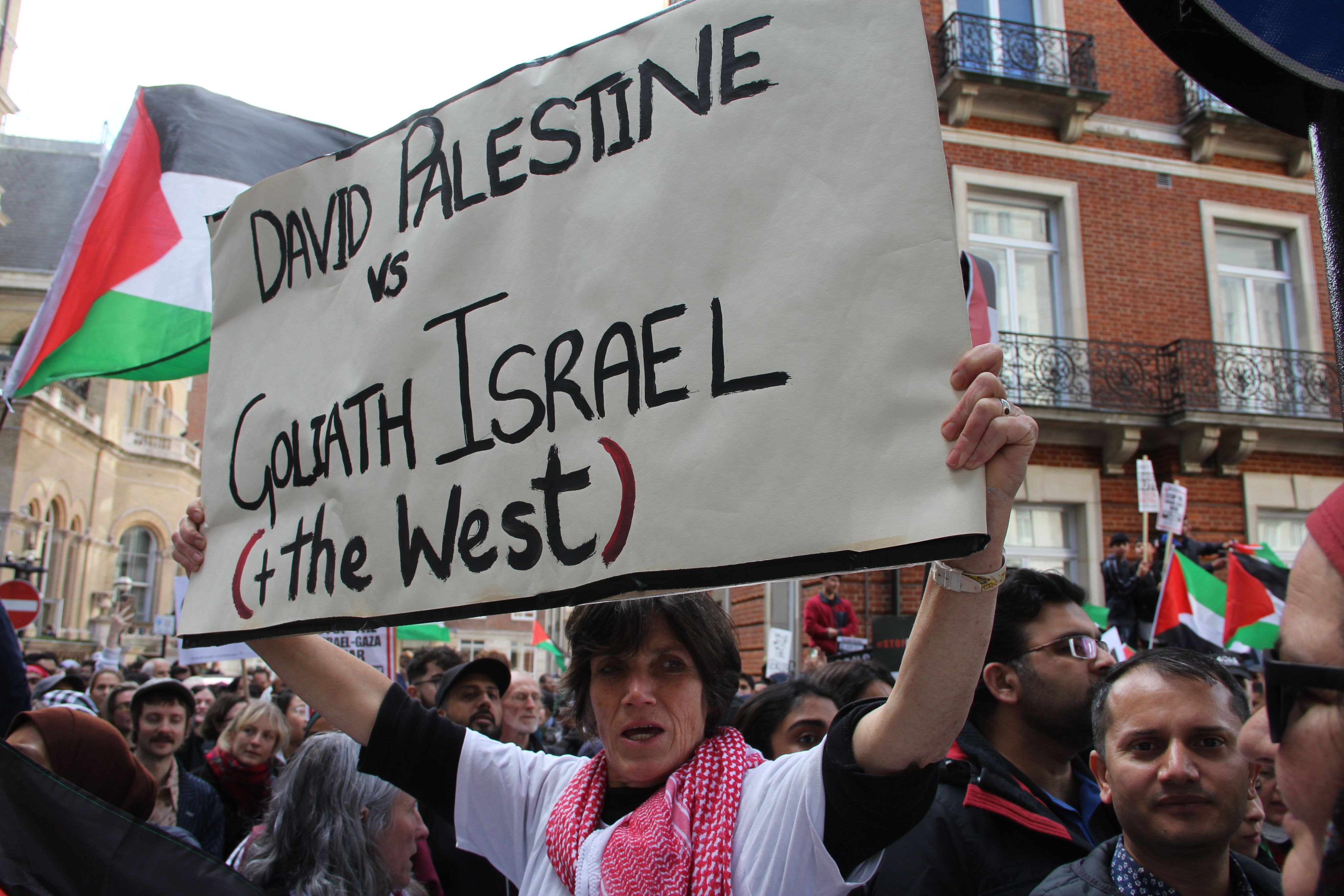



Police presence
Despite worries that the protest would turn violent, there were no significant clashes with police. The Metropolitan Police reported 15 arrests in relation to the protests, of which three have been charged. This did not mean that there were few officers present. The Met Police deployed nearly a thousand officers in anticipation of the protests.
The picture on the top right below shows a confrontation between a man and police who were telling him to remove his balaclava. Certain parts of London are covered by a legal power that requires a person to remove items of clothing that conceal their identity. However, as the protest went on, this power went unenforced as there were too many people covering their faces.
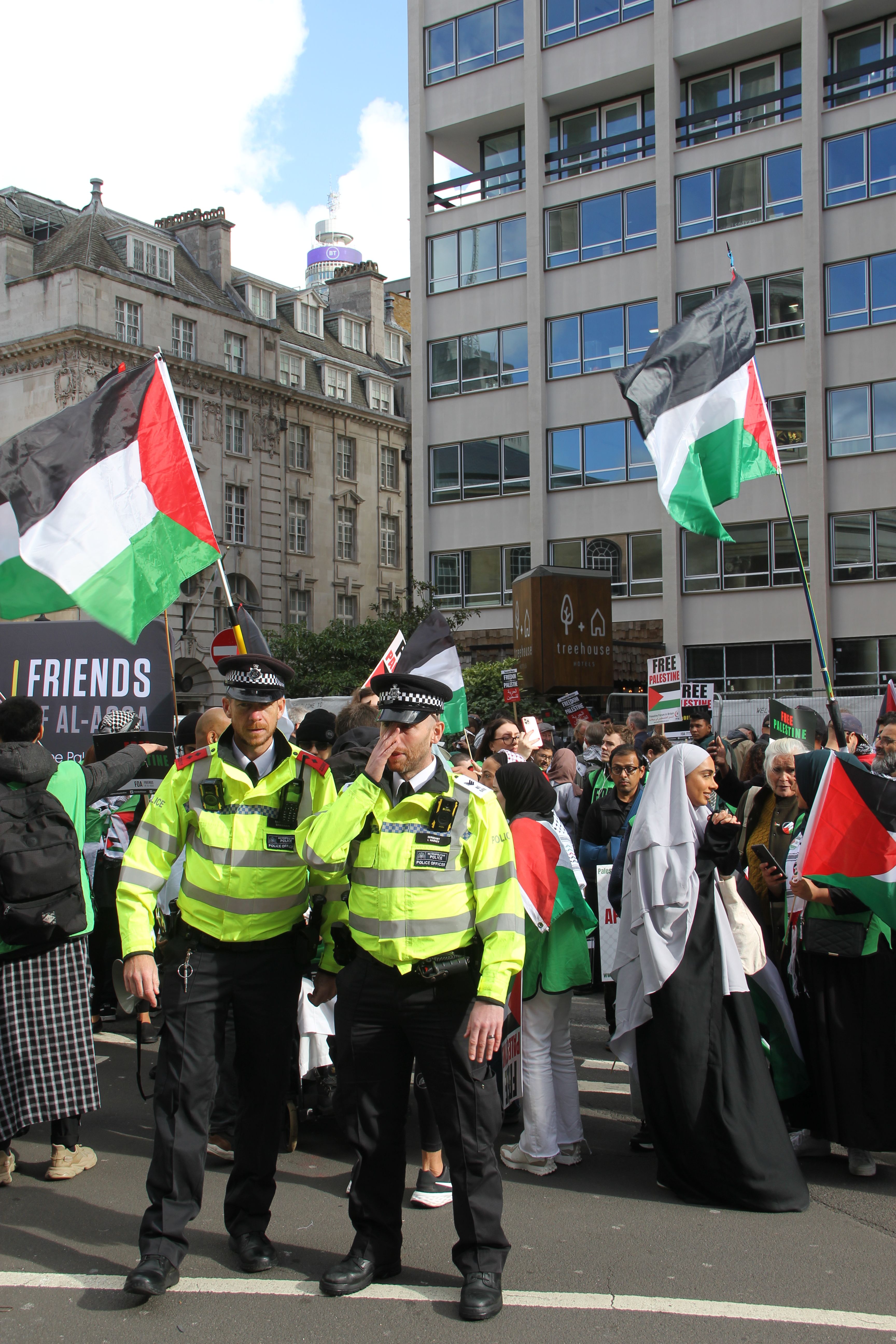
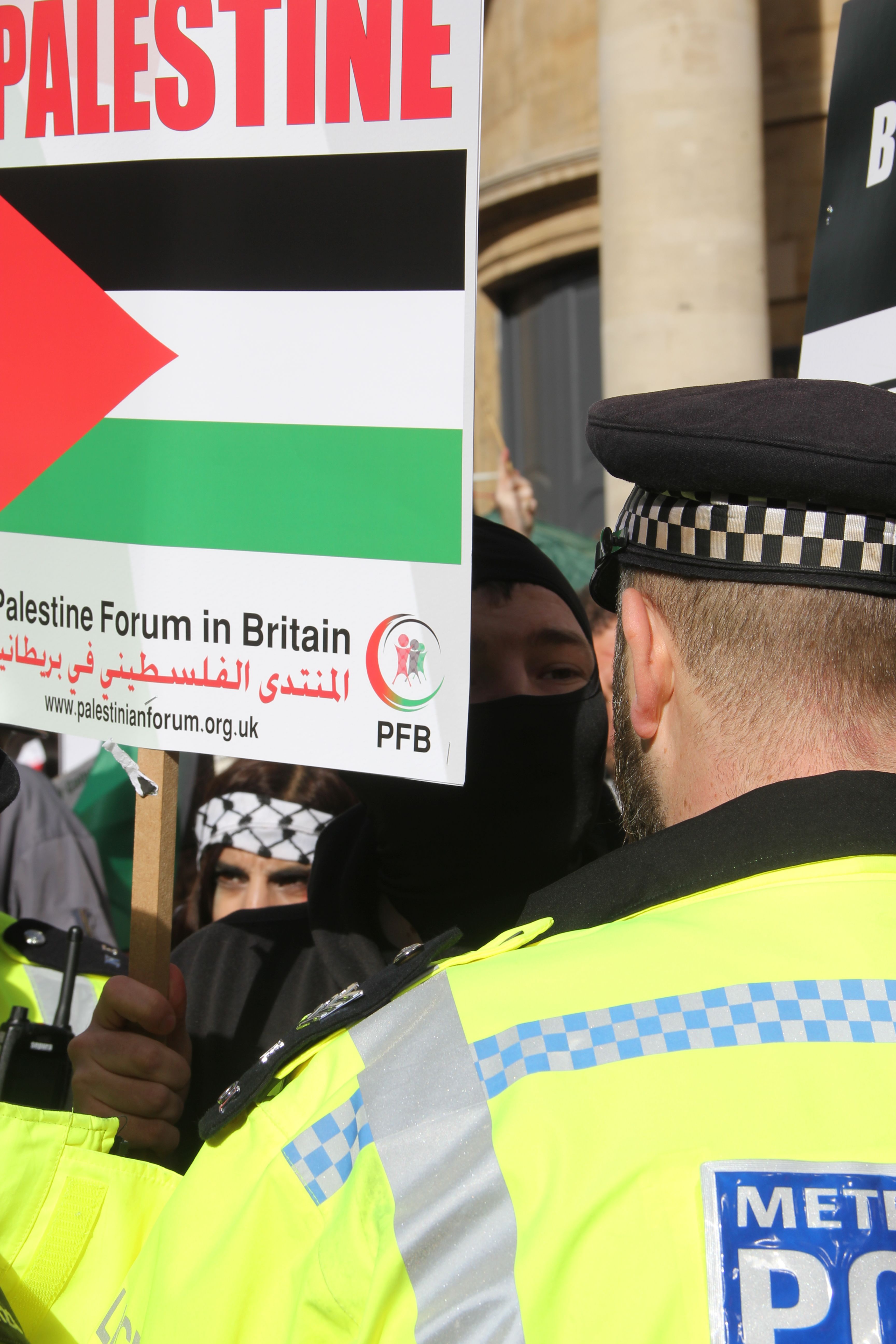
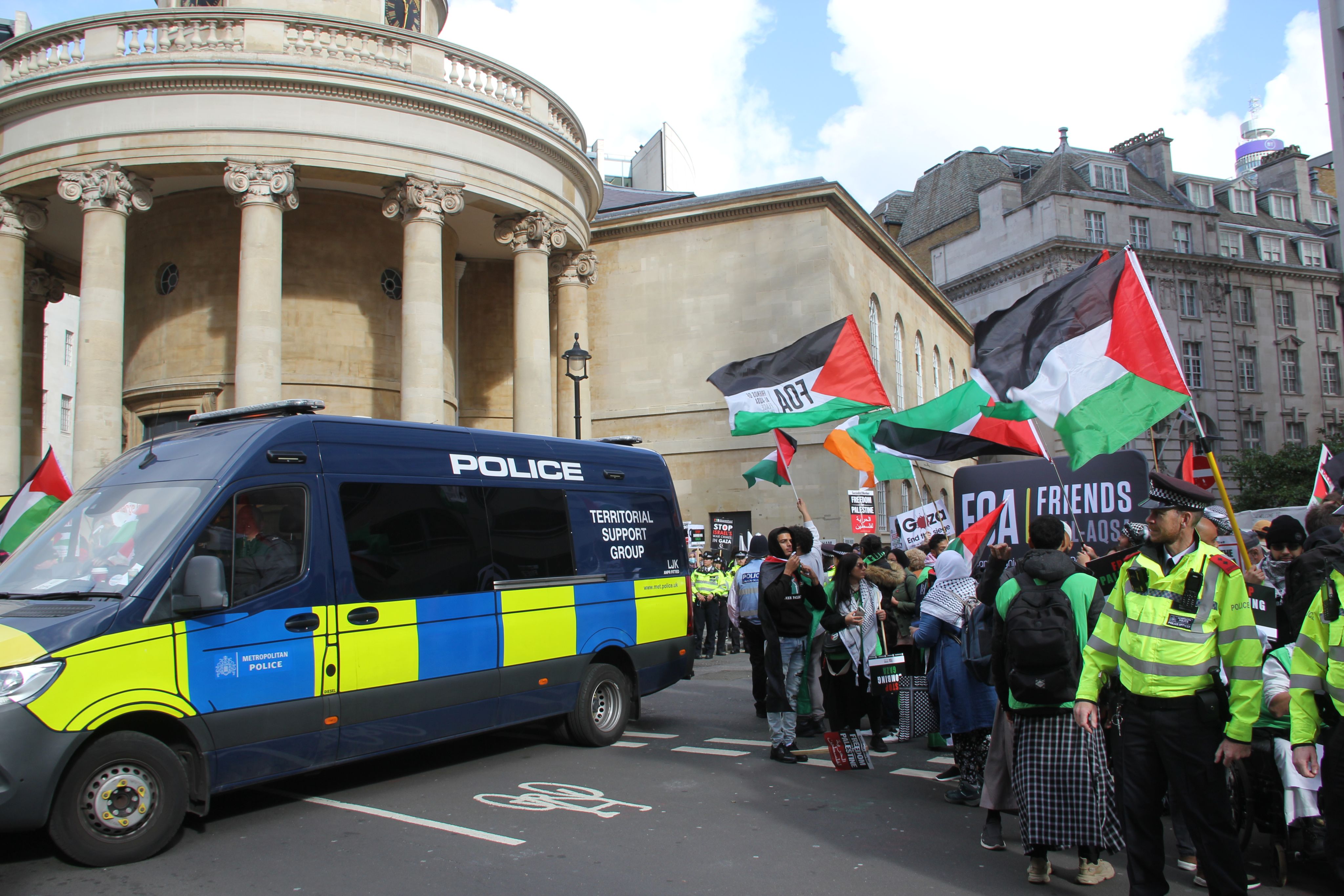



Protestors started to amass in large numbers outside of Langham Place at 11:00 AM. At 11:30, the roads became blocked with no passage for cars through from BBC Broadcast House to Oxford Circus
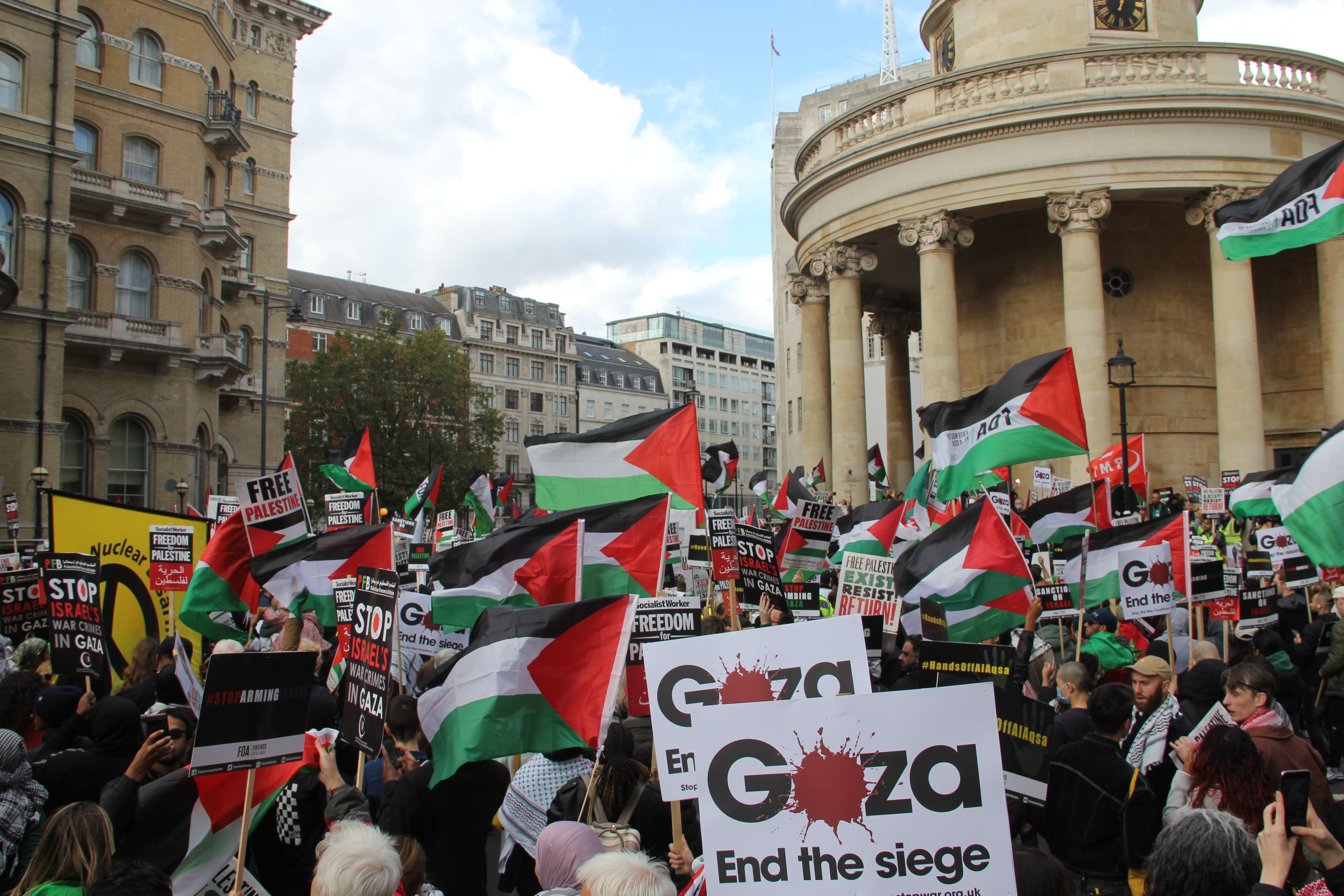
The BBC and its reporting of the crisis
The BBC has come under fire recently for standing by its editorial choice not to label Hamas as a terrorist organisation unless they are attributing it to someone else. This has led to over 1500 complaints from the public which are roughly a 50-50 split between complaints of bias towards Israel and complaints of bias towards Palestine. The UK Defence Secretary Grant Shapps described the BBC’s policy as “verging on disgraceful”
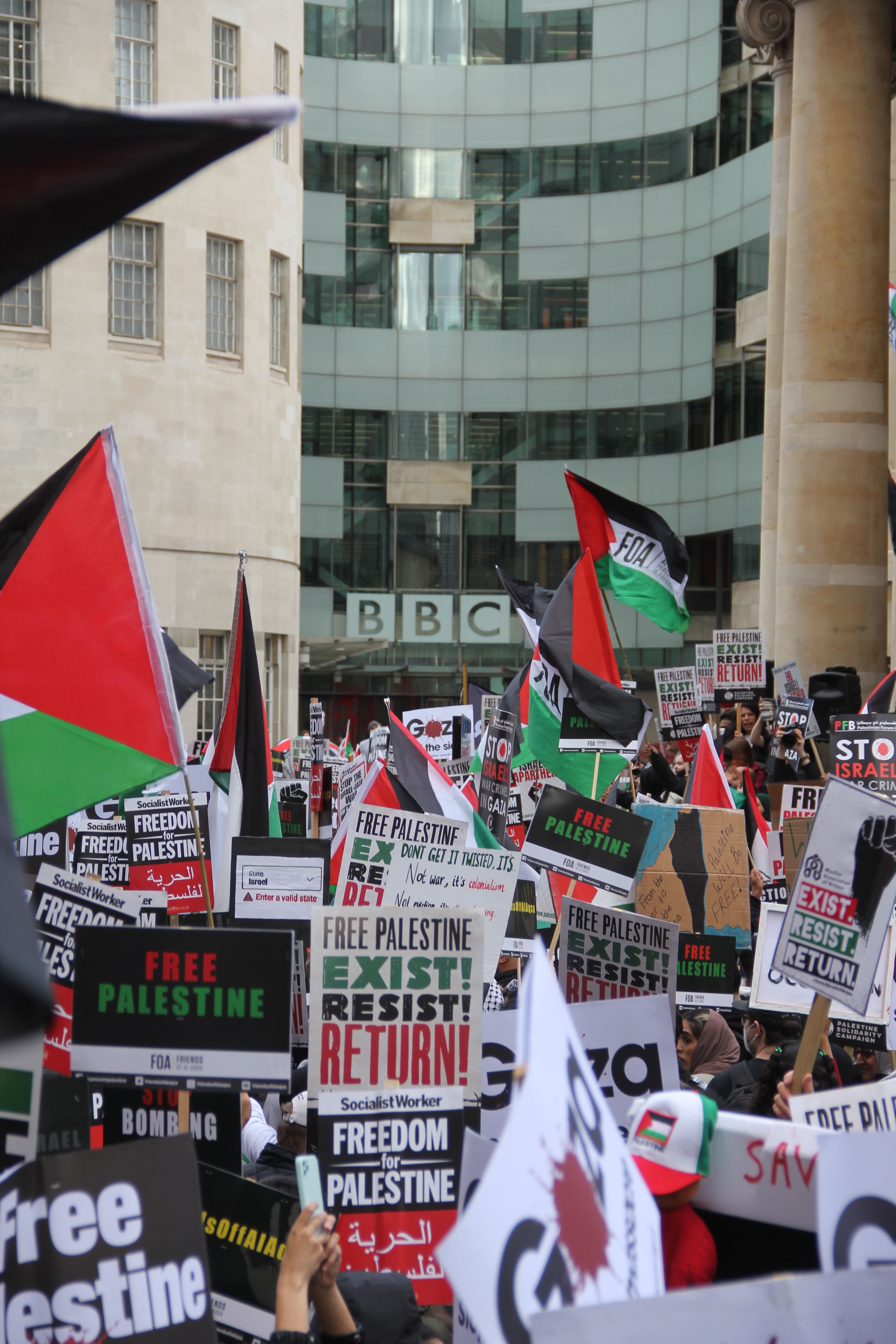
Flags of the protest
Outside of the commonplace Palestinian flag, others from across the Arab and Islamic world were present. In these photos, we have the flags of Turkey and Saudi Arabia in the top image, and in the bottom two young women are wearing Syrian opposition flags as capes.
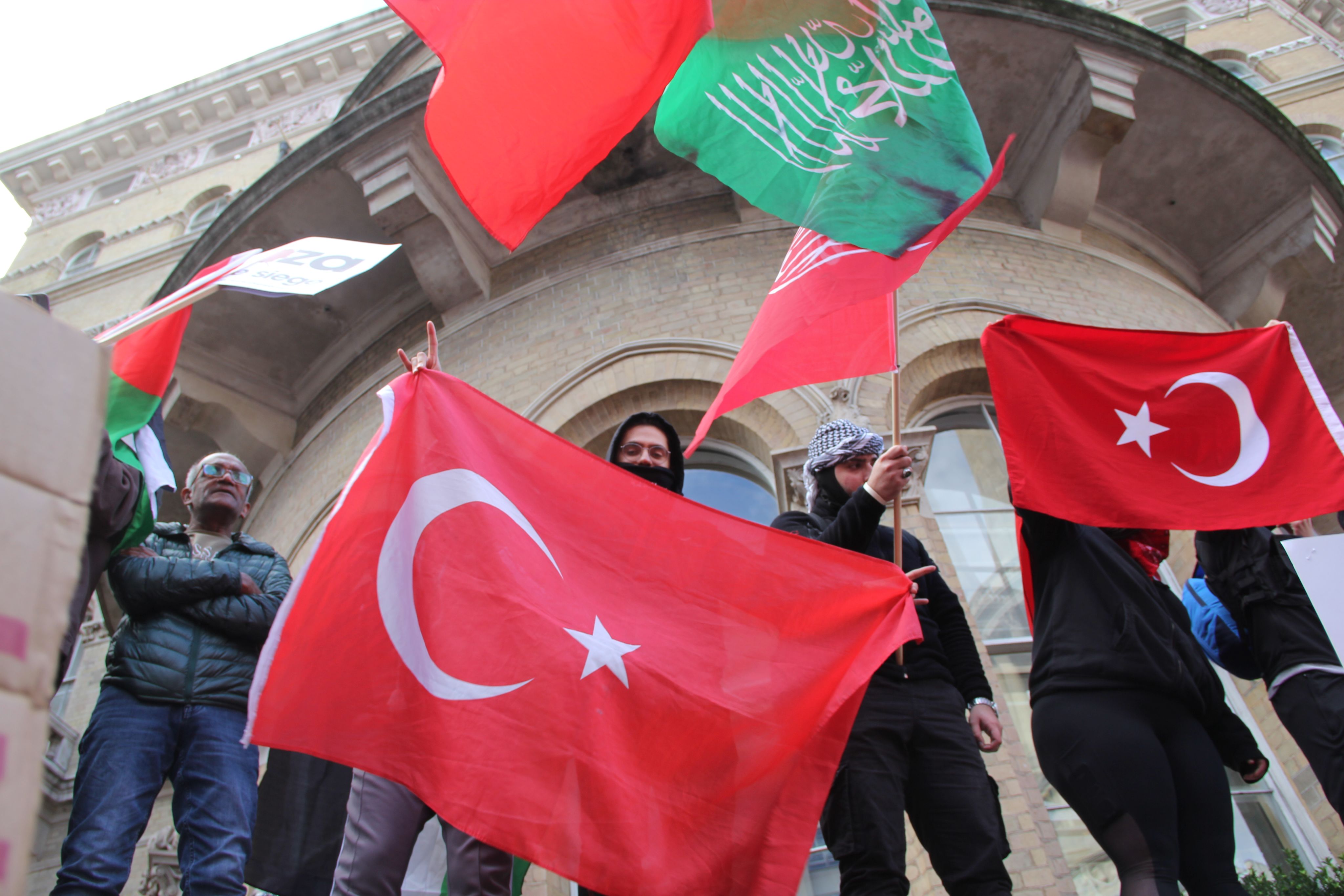
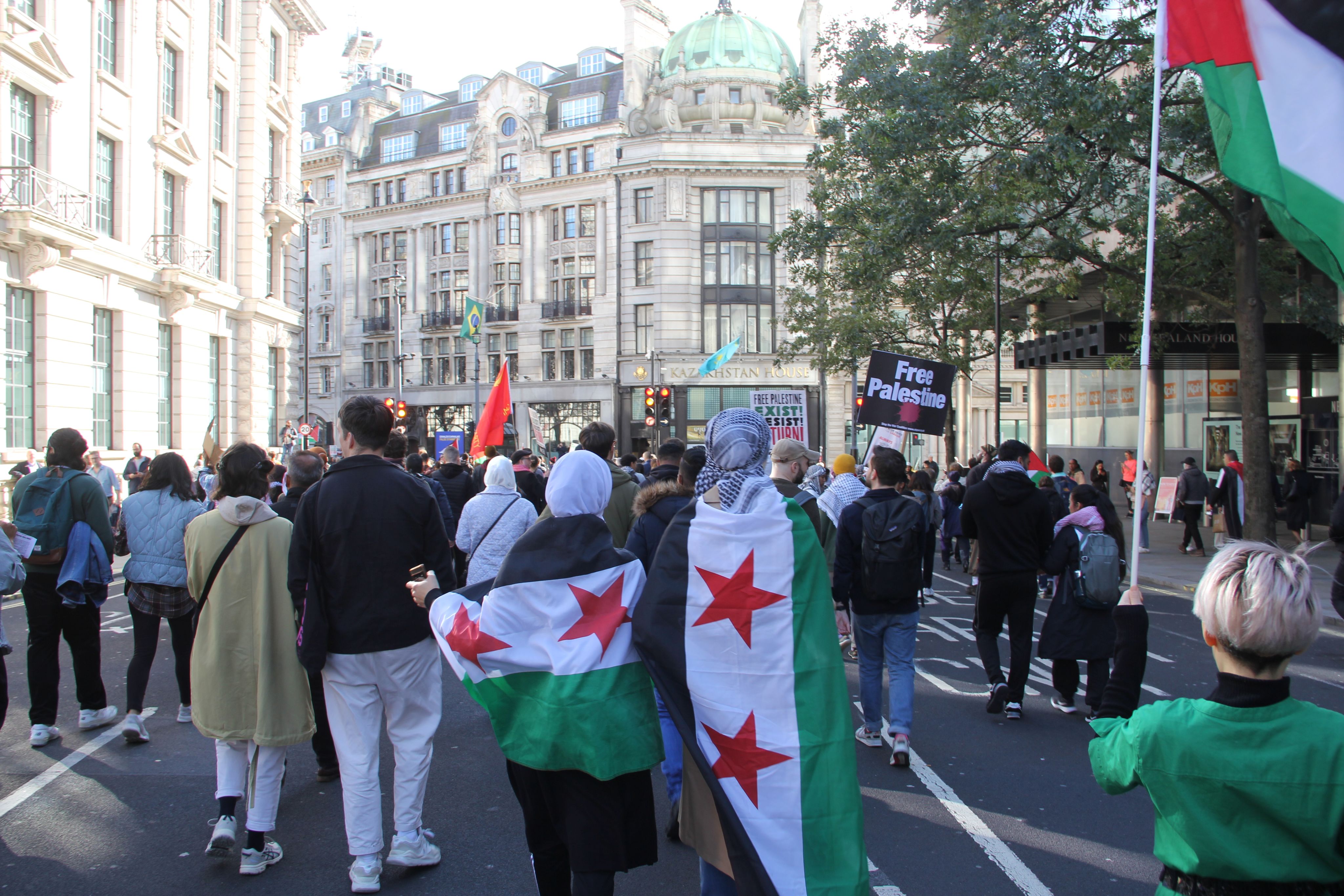


One flag that stood out was carried by a young man who wore a keffiyeh which covered his face. The flag contains the white text of the Shahada (The Islamic profession of Faith) on a black background. The flag is commonly referred to as the jihadist flag and its variations are used widely by organisations such as al-Qaeda, Islamic State and the Taliban.
The flag and its carrier drew the attention of the police, who followed him at a distance and were overheard speaking on the radio trying to get an identification of the flag. This photo was taken at the end of the march directly outside of Downing Street.
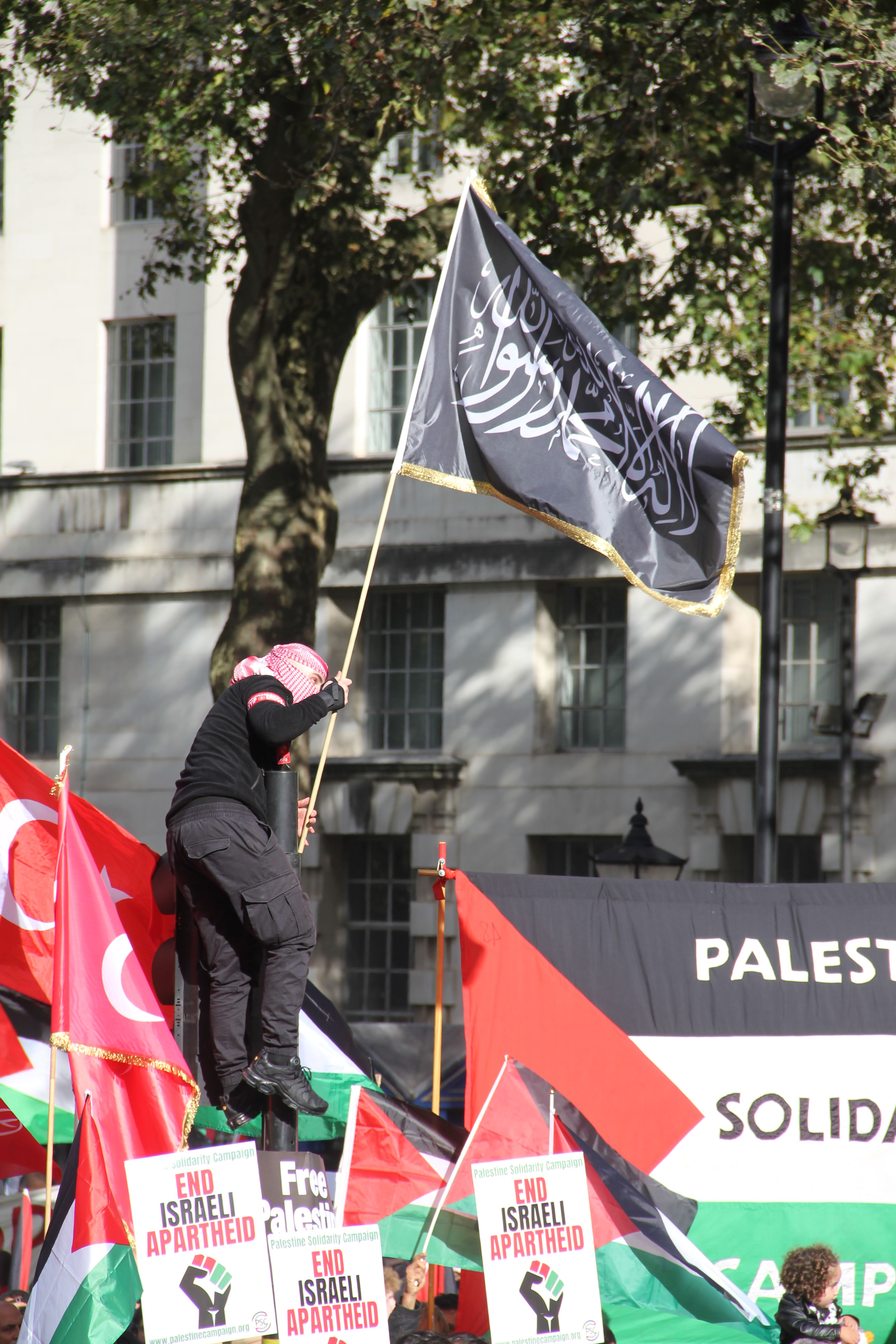

The march began at around 12:45. The route was preplanned and began at Portland Place in Marylebone. Protestors marched down Regent’s Street until they reached Trafalgar Square at which point demonstrations moved down Whitehall where they stopped outside of Downing Street. The route was almost two miles long and took nearly an hour to complete.
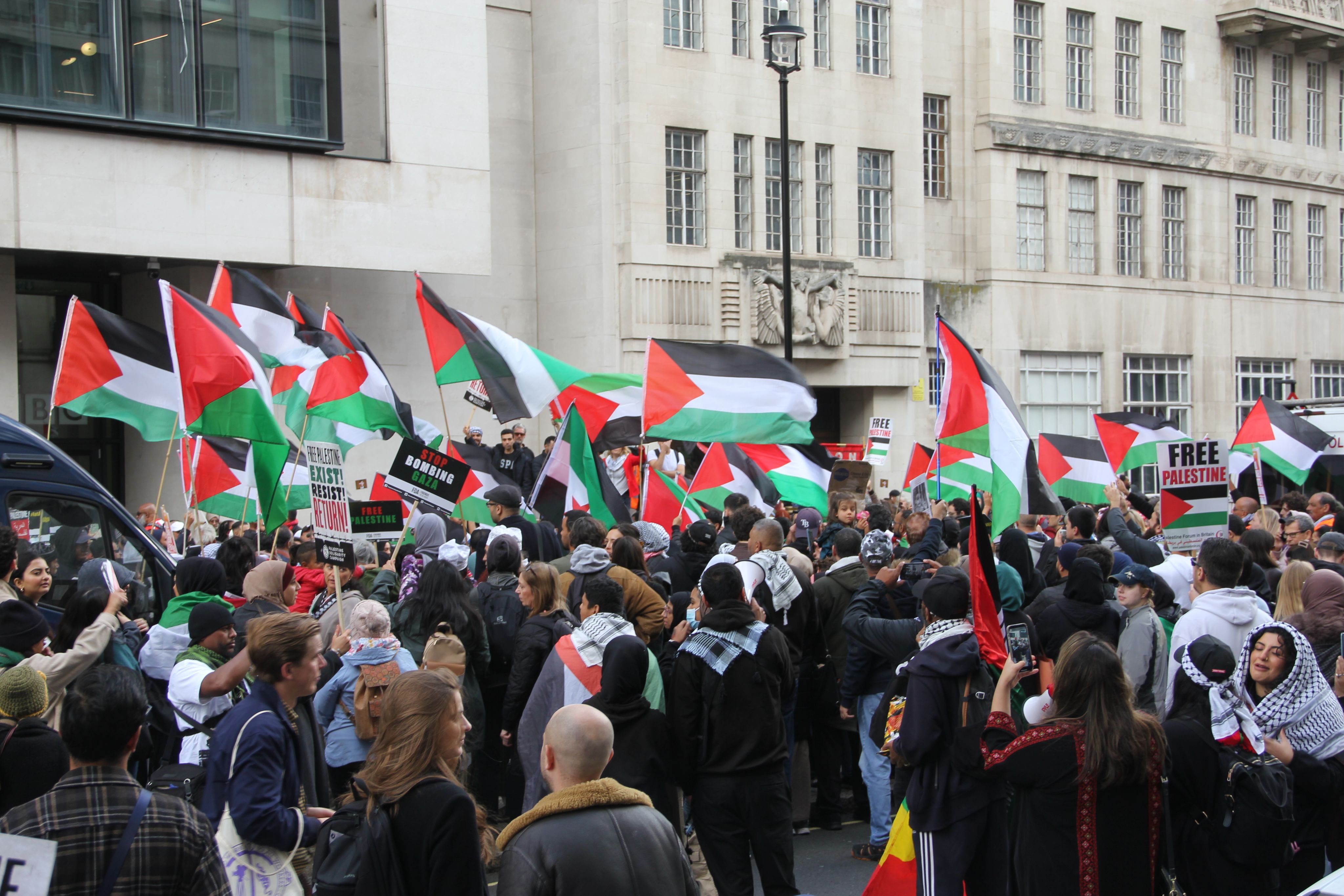
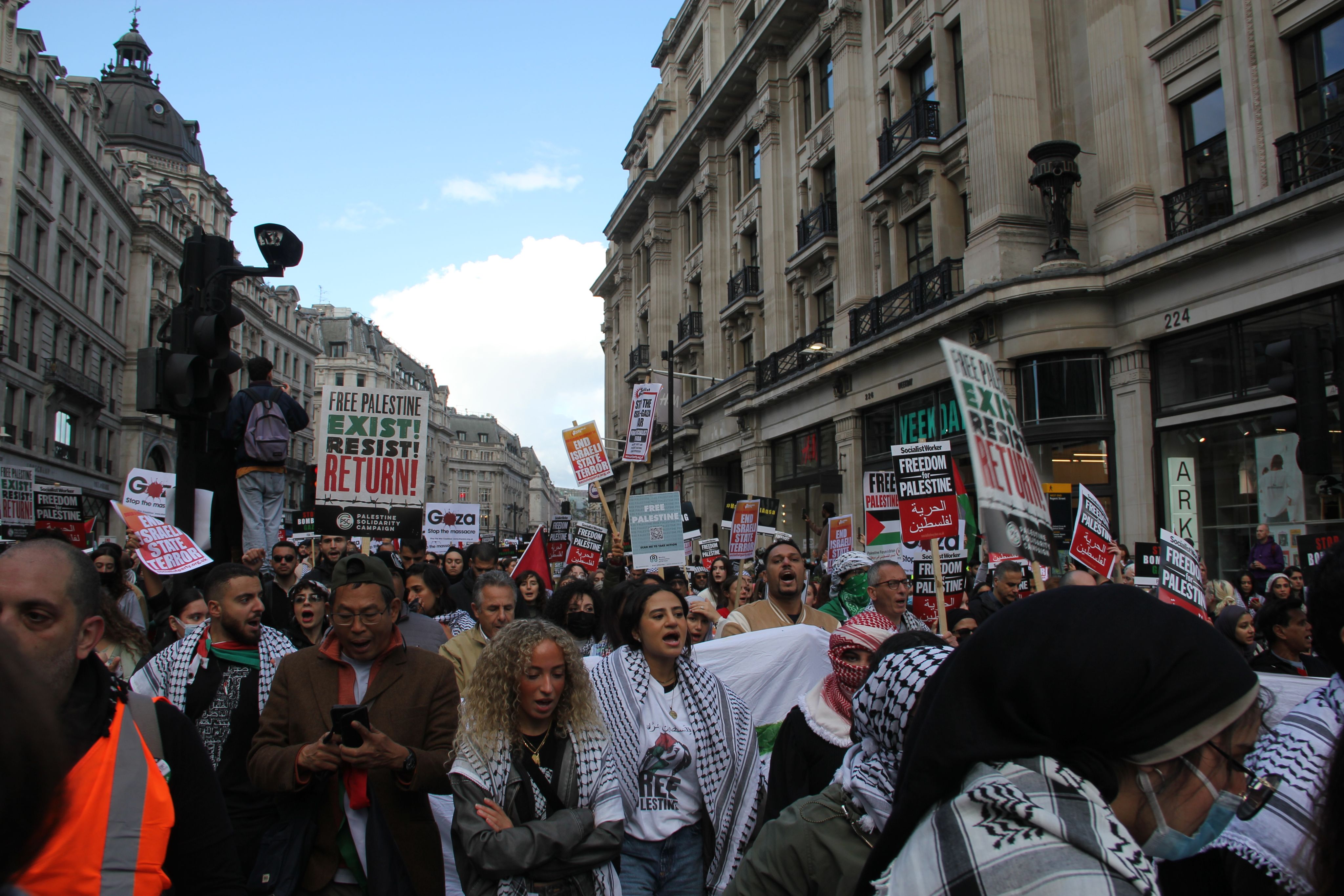


One unexpected sight along the route was three Haredi (strictly Orthodox) Jews. They are part of an organisation called Neturei Karta. The name literally means “Guardians of the City” in Aramaic and they campaign for a peaceful dismantling of the state of Israel. Their belief is that the state of Israel is against the wishes of God and that Jews should not have their own state until the coming of the Jewish Messiah. They were greeted with cheers as the protestors walked past with many stopping to take photos and shake hands with them.
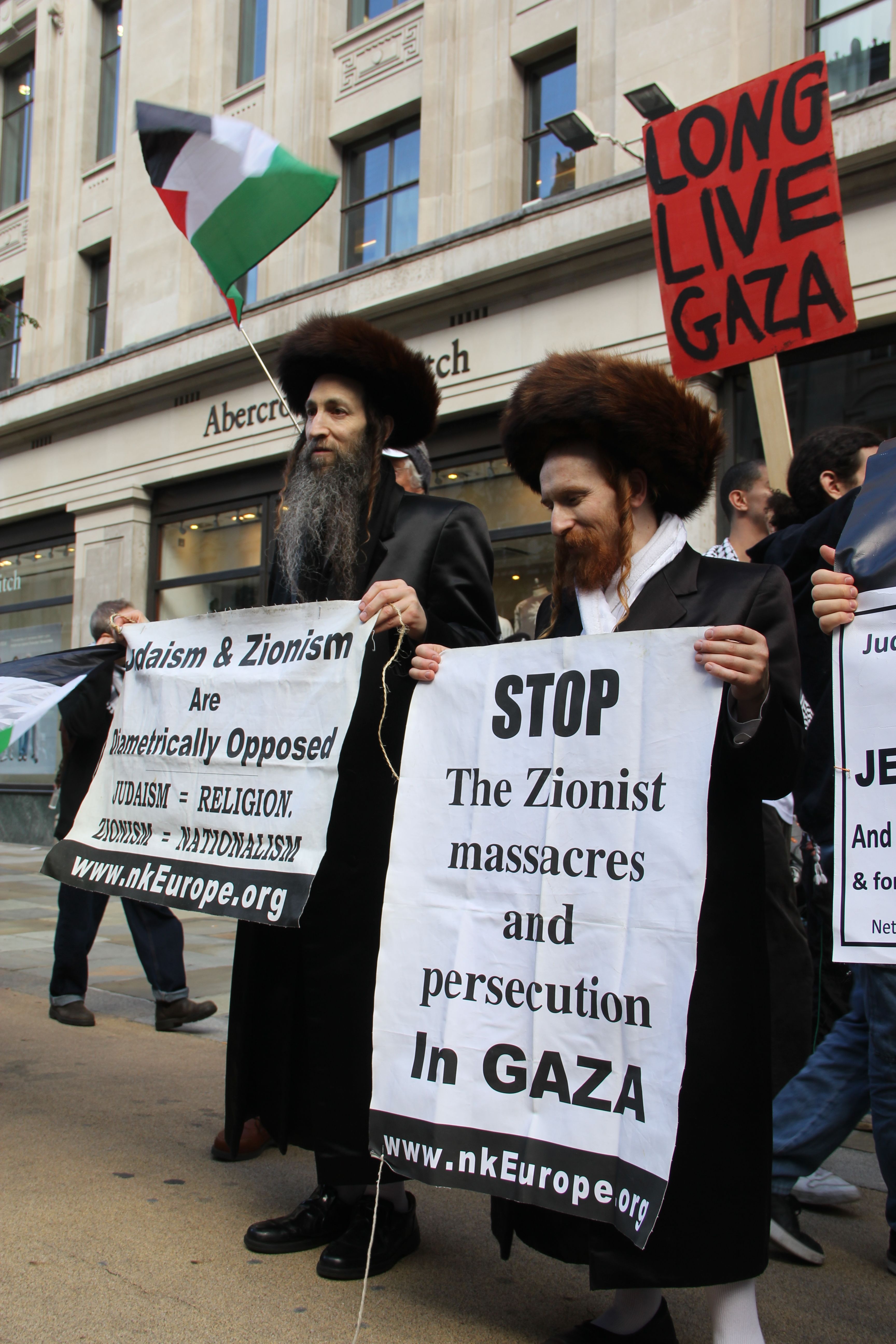

Protestors exit Trafalgar square via Whitehall with Big Ben watching in the background.
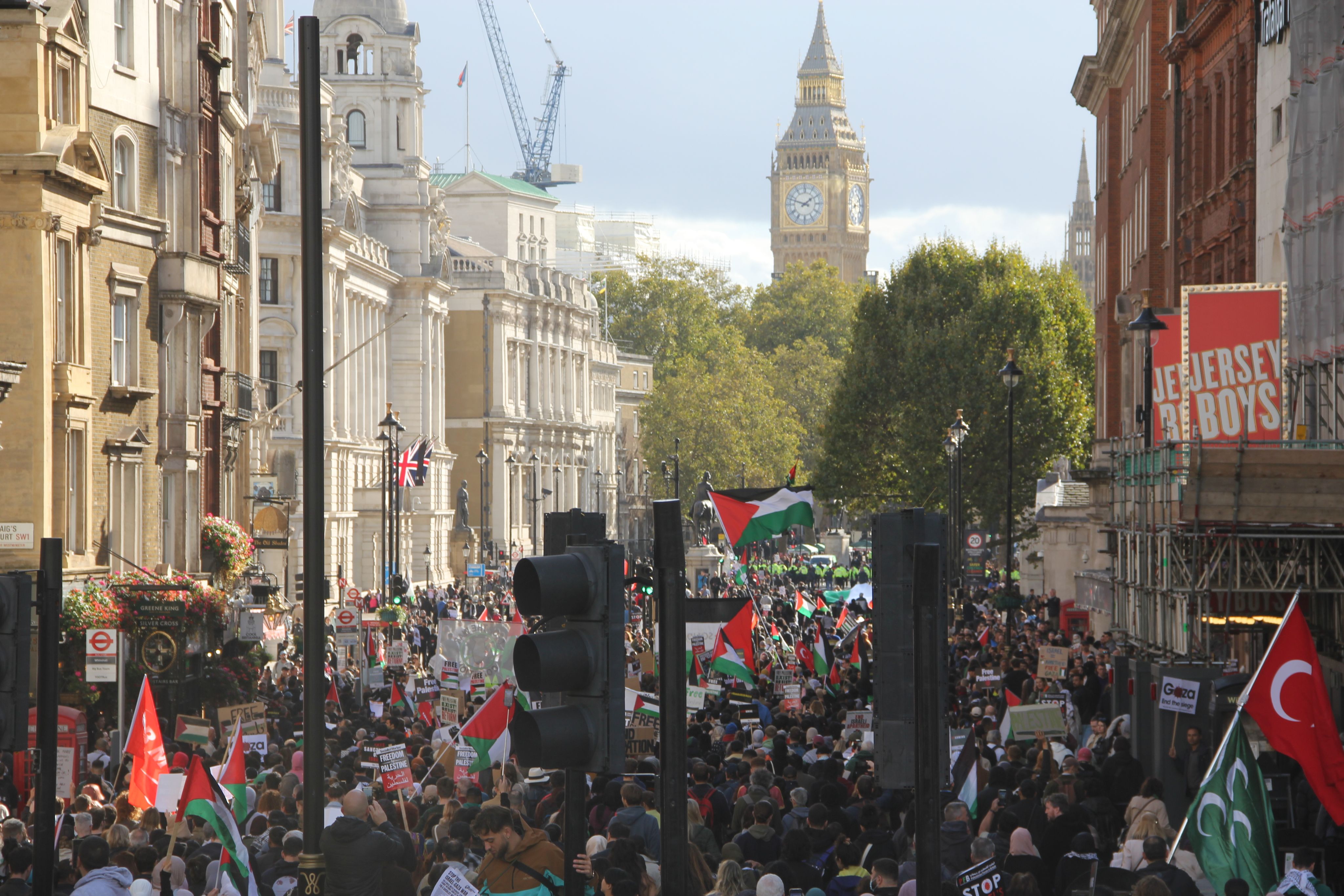
The march down Whitehall saw protestors walk past numerous memorial statues and monuments. Pictured is the Women of World War II memorial surrounded by a plethora of Palestinian flags. Security minister Tom Tugendhat said that it was “disgraceful” that the march ended by a stage that was erected close to the Cenotaph.
Mr Tugendhat also stated that “For many of us it is a very living memory to our friends we lost in Iraq and Afghanistan” and that he would do “everything I can in making sure it is not allowed to happen again.”
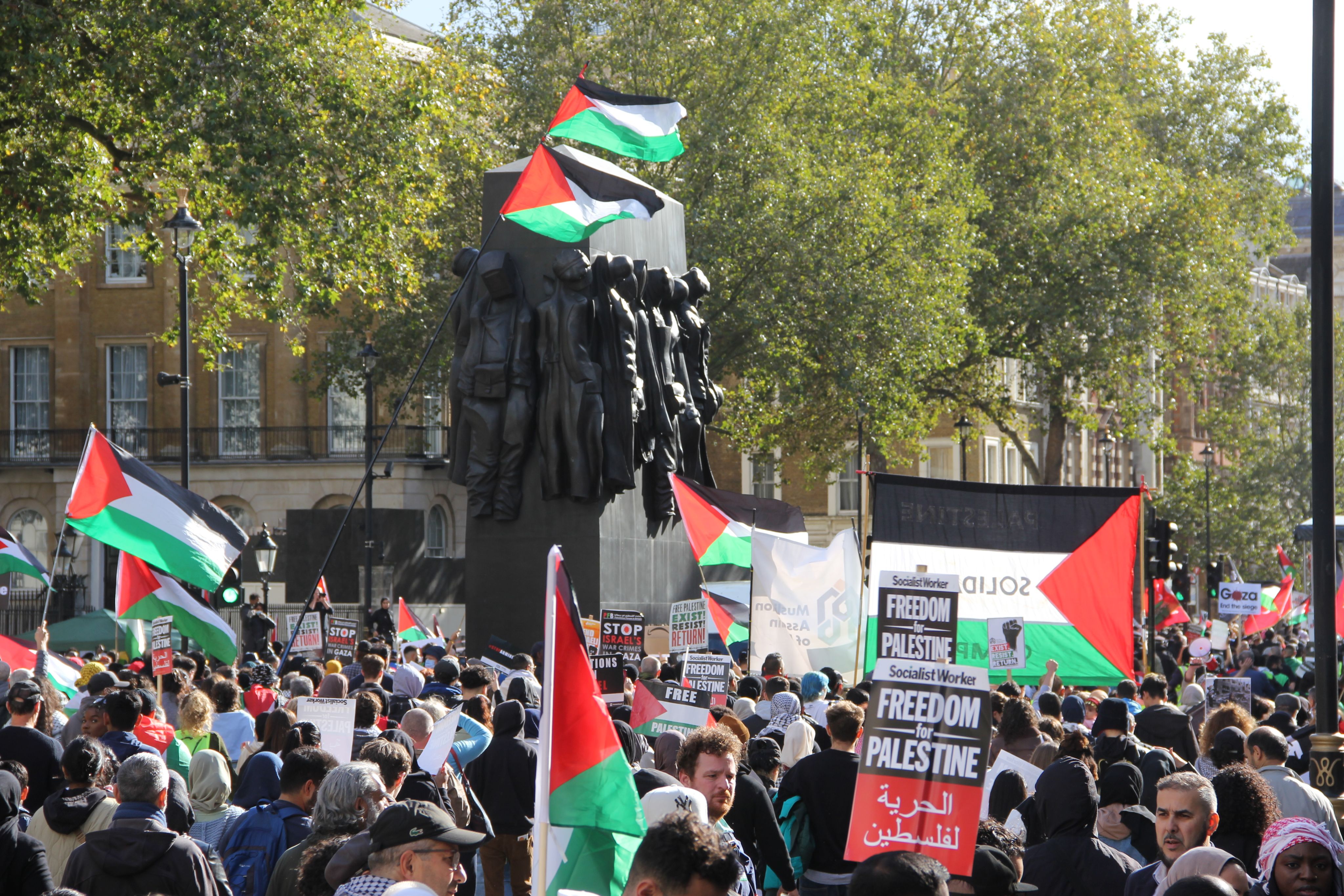
There was heavy police presence all throughout Whitehall. At least 20 Police officers stood outside temporary barriers erected outside Downing Street. They were carrying protective helmets and other riot gear and were prepared for a potentially violent demonstration outside. This violence never manifested, however.
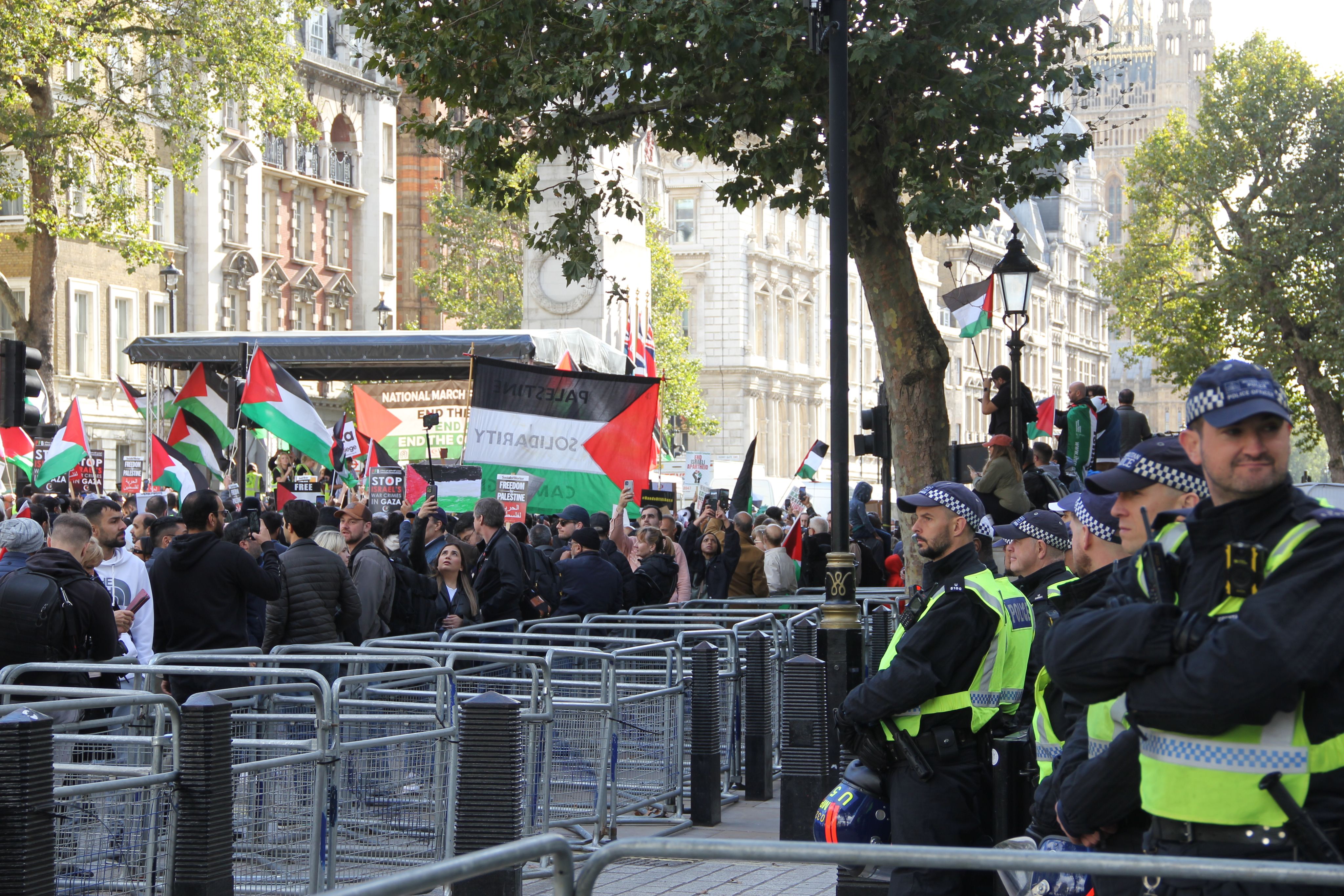
As speakers started to appear on the stage outside of Downing Street a few smoke bombs were ignited, and a sea of Palestinian flags were waving in the breeze from The Cenotaph all the way to Trafalgar Square. Chants of “Rishi Sunak shame on you” rang out throughout alongside others condemning the British Government’s position of support towards Israel. The crowds started to disperse at around 6pm.

The effects of the protest, if any, are yet to be seen. It will, however, be the first of many across the country. More protests occurred on 21 of October and more will no doubt be organised as the crisis continues. Most major cities in the UK have seen some form of pro-Palestine protests, the largest being in Manchester, London and Birmingham.
Since the demonstration, more than 2,400 Palestinians have been killed making the current death toll over 4,600. Alongside this 212 Israeli hostages are currently being held hostage by Hamas in Gaza. The list of casualties will only grow as the Israeli Defence Force looks set to launch a ground invasion of Gaza. If the attack is carried out it would mark the first major conflict between Israel and its neighbouring countries since the 2006 Lebanon War.
